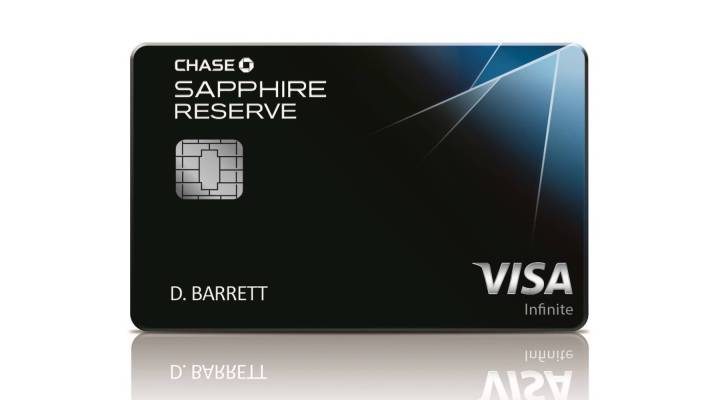
How those big credit card reward programs could help you save on insurance costs
How those big credit card reward programs could help you save on insurance costs

Credit cards with rewards programs are sometimes expensive and complicated to navigate. Their rewards vary depending on each individual’s purchasing situation and not all credit cards are on equal footing. For example, you may be wasting money $450 a year on your Chase Sapphire Reserve card if you’re not traveling and eating out very regularly.
But that doesn’t mean you can’t save money with them. We spoke with Marketplace regular, frequent traveler and founder of the Sustainable Endowments Institute, Mark Orlowski, about other reasons why those expensive credit card rewards programs could pay off even if you’re not a frequent flyer.
Below is an edited transcript of their conversation.
David Brancaccio: Just looking at that Chase Sapphire Reserve card — I mean, that thing generates more buzz than the iPhone X and Tesla’s electric car for the middle class. It’s just a credit card.
Mark Orlowski: Well, yes, it is just a credit card. But, you know, not all credit cards are created equal.
Brancaccio: This one is like $450 a year. But there’s hundreds of dollars in credit toward travels. You can get some of it back and they’re changing the rules. Have you ever considered that expensive card like that?
Orlowski: You know, I did sign up for the Chase Sapphire Reserve card. It had, I think, a lot of great value — especially along the 100,000 point sign-up bonus that they offered last year. But it’s not right for everyone, right? Those large annual fees — if you’re not getting the benefits from it, you’re really losing money on the proposition. But if you’re traveling quite a bit, if you’re taking advantage of those benefits, the $400 annual fee first of all is offset by a $300 travel credit that covers anything from hotels to flights to even Uber and Lyft rides. So in most cases, no one will have a problem using up their credit which effectively makes it a $150-a-year credit card. Which is, you know, quite a bit of a better deal.
Brancaccio: All right. But this is what I really wanted to ask you about, Mark, which is: we all get the mailing from the credit card company that says, “Haha, surprise, we’re raising your annual fee again this year.” When you get those, what’s your response? What do you do next?
Orlowski: Well, you need to take a careful look at how much money you spent on the card, how many points or miles you earned in the last year or last couple of years. Were you able to use those miles or cash out those points? And what kind of value do they have? So that’s an important equation, right? If you only put a few thousand dollars on a card in the last year and to charge you a hundred or twenty dollars or more an annual fee probably doesn’t make sense to keep that card. Now there are exceptions. You know some cards especially more these premium cards have a whole range of really neat insurance programs related to travel and also everyday purchases that you make to help protect you when your travel plans go awry or when you drop that brand new iPhone into the toilet for example.
Brancaccio: All right well let’s start with the insurance. A lot of credit cards will offer a kind of supplemental insurance when you rent a car. But often it’s not the primary coverage you still got to go through your regular insurance company if something bad happens.
Orlowski: Exactly. So that’s one case where that Chase Sapphire card actually does shine. It gives you primary insurance both when you’re in the U.S. renting a car and abroad which means you don’t have to file a claim with your regular car insurance policy which is very nice. Other cards like the Prestige card which is a direct competitor to the Chase Sapphire card offers that same primary benefit but only when you’re traveling internationally. So if you’re doing a lot of domestic car rental, still better to use that than say a debit card or a car that doesn’t offer any secondary insurance but it will still make you file a claim with your auto insurance. Although they will typically with the secondary coverage, they will cover the deductible that you have to pay out on a claim with your insurance but that doesn’t necessarily help that much because your rates may be going up with your primary insurance, if you have to file a claim.
Brancaccio: All right so check the fine print or not so fine print on that. And also you know many of us pay a little extra when we get a new phone for the insurance in case we end up destroying the screen or dropping it into water. Some cards can help?
Orlowski: Yes, so there’s two different types of protection that you can have on a card for accidental sort of damage. One is a much broader policy that the Amex platinum card has, many other AmEx cards cover, many of the city cards have as well as many of the Chase Sapphire and other Chase cards cover which is basically called a purchase protection or similar named item. And what it does is basically the first three months or sometimes the first four months it will actually cover basically all accidental damage that you might have happened to a cell phone or other electronic item or clothing item or something of the sort. You can file a claim and typically they’ll cover the full cost item and you usually ship back that broken or damaged item back to them and they will give you the full purchase price back even if you bought the item three, almost four months ago. That’s very nice. Now what if you bought the phone six months ago and you drop it in a toilet?
Brancaccio: Then what, a card could help?
Orlowski: Well many people might be out of luck and they may be looking at spending $600, $800 or more for a new phone or having to sign other contracts in order to get a phone for less. But there are few credit cards. Many of the Wells Fargo credit cards, the Chase Ink business preferred credit card and then also the new Uber Visa credit card. They all offer phone insurance for free as a benefit as long as you charge your monthly cellphone bill to their credit card. And they usually cover up to $600 per claim. Sometimes multiple claims a year. Hopefully you won’t need to use that and the deductible ranges from$25 for the last two to $100 for the Chase.
There’s a lot happening in the world. Through it all, Marketplace is here for you.
You rely on Marketplace to break down the world’s events and tell you how it affects you in a fact-based, approachable way. We rely on your financial support to keep making that possible.
Your donation today powers the independent journalism that you rely on. For just $5/month, you can help sustain Marketplace so we can keep reporting on the things that matter to you.


















